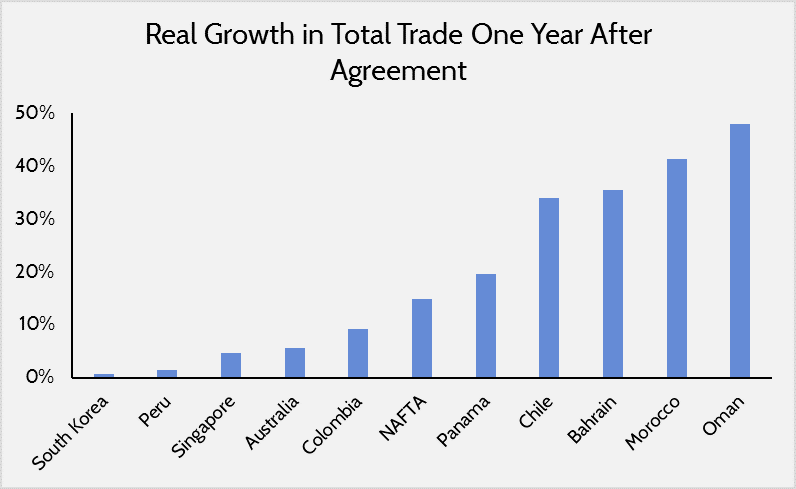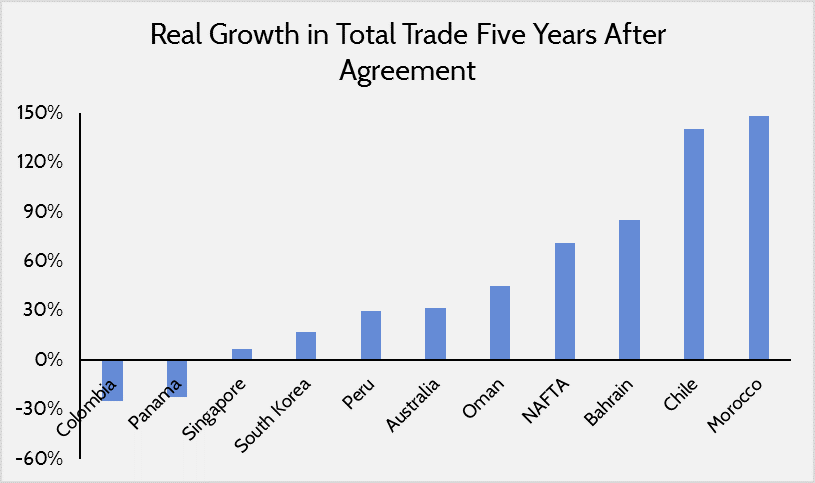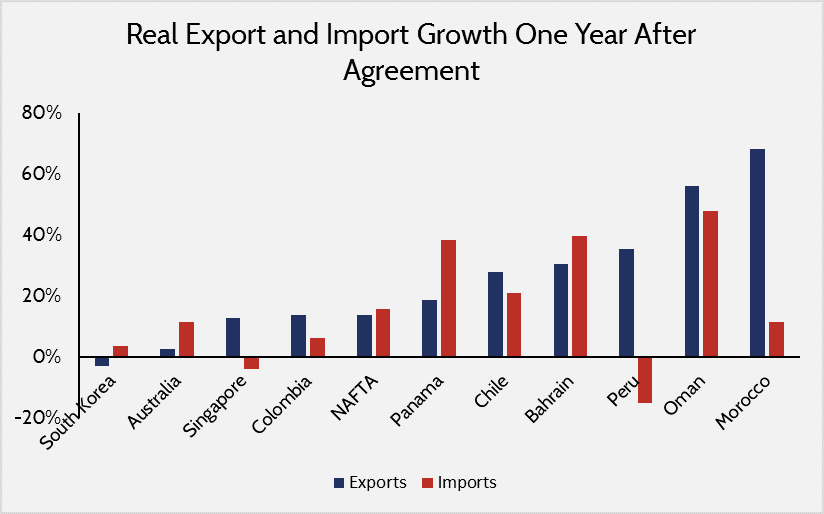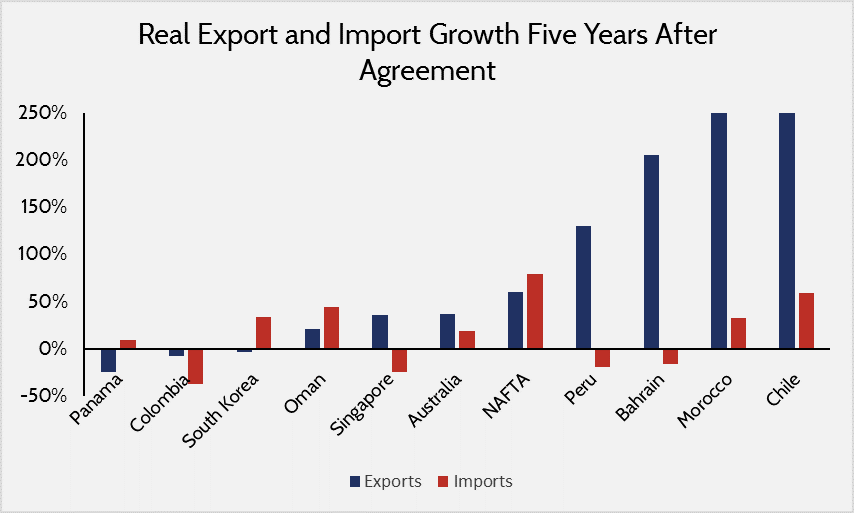Research
February 14, 2017
Assessing Bilateral and Multilateral Trade Agreements
Executive Summary
- President Trump has pledged to abandon all multilateral trade negotiations and to solely negotiate bilateral trade agreements for the United States
- However, there is no evidence that bilateral trade agreements have produced better economic results than trade agreements with more than one country
- The Trump administration should equally evaluate all current and future trade agreements on their merits instead of confining the United States to bilateral negotiations
President Trump has been very clear about his intention to overhaul U.S. trade policy. Days after taking office, he issued a presidential memorandum withdrawing the United States from the Trans-Pacific Partnership. This was a 12-nation trade agreement aimed at increasing our economic and strategic links to the Asia-Pacific. He subsequently pledged to abandon all multilateral negotiations in favor of bilateral trade agreements with nations such as the United Kingdom and Japan.
Trump and his team argue that bilateral negotiations produce trade deals that are more beneficial to the United States. In a speech outlining his priorities after the election, the president-elect proclaimed “we will negotiate fair, bilateral trade deals that bring jobs and industry back onto American shores.” Peter Navarro, the head of Trump’s new White House National Trade Council, holds similar views: “the problem with multilateral deals is we reduce our bargaining power and we surrender our sovereignty.” These criticisms stem from the belief that trade negotiations with several other countries require the United States to make more concessions than trade negotiations with only one partner, resulting in deals that harm the U.S. economy.
President Trump’s fierce opposition to multilateral trade agreements raises an important question: do bilateral trade deals produce more economic growth in the United States than multilateral deals?
It can be difficult to find a causal relationship between specific trade agreements and economic health. However, examining the growth of trade following new trade agreements is a useful proxy. This is appropriate because the primary aim of trade agreements is to boost trade between partners, and international trade is an engine of economic growth. It expands market access for U.S. exporters, lowers input costs for U.S. manufacturers, and lowers prices for U.S. consumers.
The following charts show the percentage increase in total trade (U.S. exports plus U.S. imports) with our partners one and five years after multiple U.S. trade agreements entered into force. These include the North American Free Trade Agreement (NAFTA) between the United States, Mexico, and Canada, as well as bilateral agreements with ten other nations. To calculate the real growth in total trade, the dollar values of U.S. exports and imports were adjusted by the export and import price indices, respectively.
The trade agreements displayed above produced widely different growth effects for the United States. For instance, total trade with Oman grew 48 percent one year after the U.S.-Oman Free Trade Agreement (FTA) was enacted, while trade with South Korea expanded less than one percent after KORUS. Similarly, in the five years after enactment, trade with Morocco jumped almost 150 percent while trade with Colombia fell 25 percent. However, the growth generated by NAFTA consistently fell in the middle. It would be incorrect to assert that bilateral agreements have always produced larger gains for the United States than NAFTA, just as it would be incorrect to assert the opposite.
It is important to note that the value of imports and exports are highly dependent on economic conditions around the world and in the United States. When the global economy slows, global demand falls and the United States exports less. Likewise, when the U.S. economy weakens, U.S. demand for imports falls. However, examining the growth in trade both one and five years after each deal went into effect gives a good overall indication of their effects on trade.
Below is data for the same eleven trade agreements broken down into export growth and import growth. The charts show a similar pattern: NAFTA generated greater export gains than some bilateral agreements and smaller gains than others. For example, five years after implementation, exports to Canada and Mexico were up 61 percent. This is a greater jump than the 36 percent increase in U.S. exports to Singapore following the U.S.-Singapore FTA, but a weaker increase than the 131 percent export growth following the U.S. trade agreement with Peru.
Critics of NAFTA point to the fact that U.S. imports, especially from Mexico, significantly increased following NAFTA’s enactment. Indeed, U.S. imports from Canada and Mexico grew 80 percent in the five years following NAFTA, more than any other trade agreement shown above. This in turn has exacerbated our trade deficit with Mexico. However, this is not necessarily an indication of NAFTA’s failure.
When the U.S. exports, it trades goods and services for dollars. But when the U.S. imports, it gives consumers access to the benefits of innovation and international competition. This drives down the price of consumption while simultaneously encouraging high quality. Americans’ purchasing power and quality of life is just as important as the dollar-value difference between exports and imports.
Imports are likewise valuable for producers: One study found that imports from developing countries such as China reduced costs for American businesses enough to counter the effects of inflation. The argument against imports also ignores today’s complex, integrated supply chains. For example, American manufacturers now create approximately 40 percent of the content of Mexican imports and 25 percent of the content of Canadian imports. Furthermore, over half of all U.S. imports are used by American manufacturers in production.
The evidence shows that both bilateral and multilateral trade agreements have benefited the United States economically. Instead of confining the United States to bilateral negotiations, the Trump administration should consider all potential trade agreements as an opportunity to strengthen our strategic relationships and spur economic growth.














